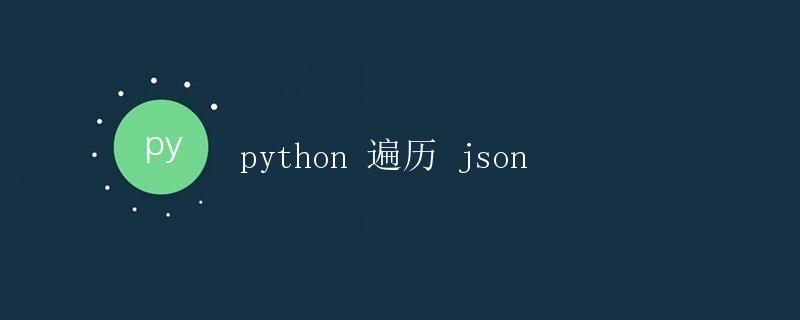Python遍历JSON数据

在编程中,JSON(JavaScript Object Notation)是一种常见的数据格式,用于存储和交换数据。Python作为一种流行的编程语言,提供了许多方法来处理JSON数据。在本文中,我们将介绍如何使用Python来遍历JSON数据,包括读取JSON文件、解析JSON字符串以及遍历复杂的嵌套JSON数据结构。
读取JSON文件
首先,让我们看看如何使用Python读取和解析一个包含JSON数据的文件。假设我们有一个名为data.json的文件,内容如下:
{
"name": "geek-docs.com",
"url": "https://geek-docs.com",
"topics": ["Python", "Machine Learning", "Web Development"]
}
我们可以使用Python的json模块来读取和解析这个JSON文件,示例代码如下:
import json
# 读取JSON文件
with open('data.json') as f:
data = json.load(f)
# 打印解析后的数据
print(data)
运行以上代码,我们将得到如下输出:
{'name': 'geek-docs.com', 'url': 'https://geek-docs.com', 'topics': ['Python', 'Machine Learning', 'Web Development']}
通过以上代码,我们成功地读取了JSON文件并将其解析为Python字典,然后可以方便地访问和操作其中的数据。
解析JSON字符串
除了从文件中读取JSON数据,我们还可以解析JSON格式的字符串。例如,我们有以下JSON格式的字符串:
json_str = '{"name": "geek-docs.com", "url": "https://geek-docs.com", "topics": ["Python", "Machine Learning", "Web Development"]}'
我们可以使用json.loads()方法将这个字符串解析为Python字典,示例代码如下:
import json
# JSON字符串
json_str = '{"name": "geek-docs.com", "url": "https://geek-docs.com", "topics": ["Python", "Machine Learning", "Web Development"]}'
# 解析JSON字符串
data = json.loads(json_str)
# 打印解析后的数据
print(data)
运行以上代码,我们将得到如下输出:
{'name': 'geek-docs.com', 'url': 'https://geek-docs.com', 'topics': ['Python', 'Machine Learning', 'Web Development']}
通过以上代码,我们成功地将JSON格式的字符串解析为Python字典,这样我们就可以对数据进行操作。
遍历JSON数据
一旦我们成功地将JSON数据解析为Python字典或列表,就可以使用Python的循环结构来遍历JSON数据中的元素。例如,我们有以下JSON数据:
{
"name": "geek-docs.com",
"url": "https://geek-docs.com",
"topics": ["Python", "Machine Learning", "Web Development"]
}
我们可以使用循环来遍历topics中的元素,示例代码如下:
import json
# JSON数据
data = {
"name": "geek-docs.com",
"url": "https://geek-docs.com",
"topics": ["Python", "Machine Learning", "Web Development"]
}
# 遍历JSON数据
for topic in data["topics"]:
print(topic)
运行以上代码,我们将得到如下输出:
Python
Machine Learning
Web Development
通过以上代码,我们成功地遍历了JSON数据中的topics字段,并打印了每个主题。
处理嵌套JSON数据
有时,JSON数据可能包含嵌套结构,即在一个字段中包含更多的JSON数据。在这种情况下,我们可以使用递归方法来遍历并处理嵌套JSON数据。例如,我们有以下嵌套的JSON数据:
{
"name": "geek-docs.com",
"url": "https://geek-docs.com",
"topics": ["Python", "Machine Learning", "Web Development"],
"details": {
"created_at": "2020-01-01",
"owner": "John Doe"
}
}
我们可以使用递归方法来遍历details字段中的子字段,示例代码如下:
import json
# 嵌套JSON数据
data = {
"name": "geek-docs.com",
"url": "https://geek-docs.com",
"topics": ["Python", "Machine Learning", "Web Development"],
"details": {
"created_at": "2020-01-01",
"owner": "John Doe"
}
}
# 递归遍历JSON数据
def traverse_json(data):
for key, value in data.items():
if isinstance(value, dict):
traverse_json(value)
elif isinstance(value, list):
for item in value:
traverse_json(item)
else:
print(f"{key}: {value}")
# 调用递归函数
traverse_json(data)
运行以上代码,我们将得到如下输出:
name: geek-docs.com
url: https://geek-docs.com
topics: Python
topics: Machine Learning
topics: Web Development
created_at: 2020-01-01
owner: John Doe
通过以上代码,我们成功地使用递归方法遍历了嵌套的JSON数据,并打印了每个字段的键值对。
总之,Python提供了简单且方便的方法来处理JSON数据,包括读取JSON文件、解析JSON字符串以及遍历JSON数据。
 极客教程
极客教程